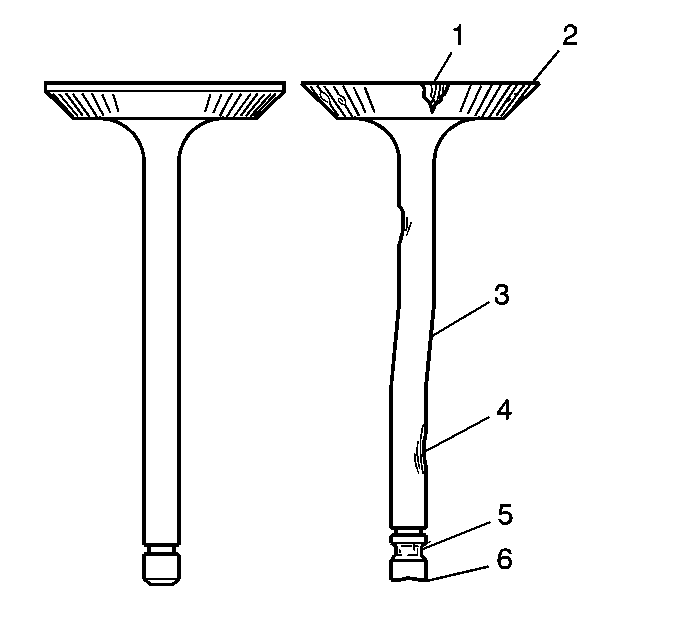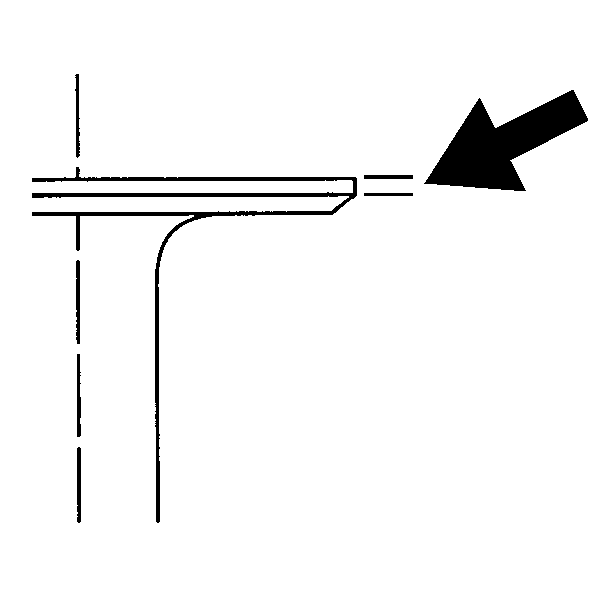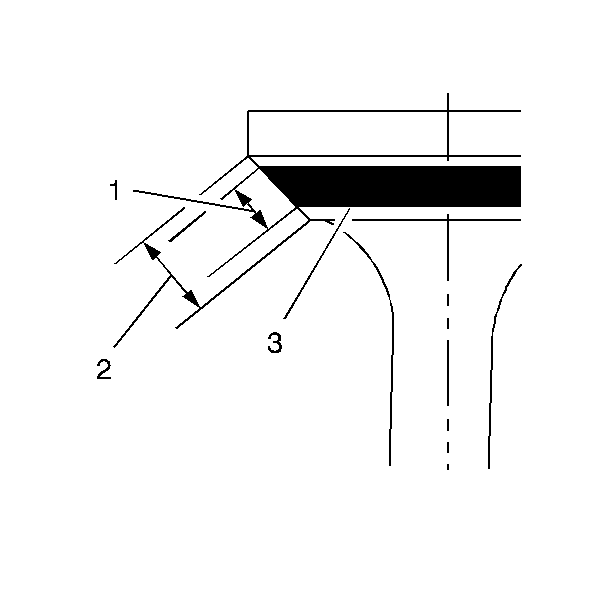Valve Cleaning Procedure
- Use soft bristle wire brush to clean any carbon build-up from
the valve head. DO NOT use a wire brush on any part of the valve stem. The
valve stem is chrome plated to provide enhanced wear characteristics. Wire
brushing the stem could remove the chrome plating.
- Thoroughly clean the valve with solvent and wipe dry.
Valve Visual Inspection Procedure

- Inspect the valve for
damage from the head to tip for the following conditions:
| • | Pitting in the valve seat area (1). |
| • | Lack of valve margin (2). |
| • | Bending in the valve stem (3). |
| • | Pitting or excessive wear in the stem (4). |
| • | Worn valve key grooves (5). |
- Replace the valve if any of these conditions exist.
Valve Measurement and Reconditioning Overview
| • | Proper valve service is critical to engine performance. Therefore,
all detailed measurement procedures must be followed to identify components
that are out of specification. |
| • | If the measurement procedures reveal that the valve or valve seat
must be reconditioned, it is critical to perform the measurement procedures
after reconditioning. |
Valve Stem Tip Height Measurement Procedure

- Check the valve stem height
by measuring the distance from the valve spring seat (the flat metal surface
of the valve stem oil seal) to the tip of the valve (1).
- Compare your measurements with the following specifications:
Intake Valve Stem Tip Height Specification
Intake valve: 35.30-36.92 mm (1.389-1.453 in)
nominal, 37.17 mm (1.463 in) maximum.
Exhaust Valve Stem Tip Height Specification
Exhaust valve: 33.85-35.38 mm (1.332-1.392 in)
nominal, 35.63 mm (1.402 in) maximum.
- If the maximum height specification is exceeded, the valve must
be replaced and the stem height re-measured.
- If the stem height with a new valve still exceeds the maximum
allowed, the cylinder head must be replaced.
Valve Seat Width Measurement Procedure

- Measure the valve seat
width in the cylinder head using a proper scale.

- Measure the seat width
on the valve face (1) using a proper scale.
Important: The seat contact area must be at least 0.5 mm (0.020 in)
from the outer diameter (margin) of the valve. If the contact area is too
close to the margins, the seat must be reconditioned to move the contact
area away from the margin.
- Compare your measurement with the following specifications:
Intake Valve Seat Width Specification
Intake valve seat width: 0.450-0.850 mm (0.017-0.033 in)
Exhaust Valve Seat Width Specification
Exhaust valve seat width: 0.700-1.100 mm (0.027-0.043 in)
- If the seat widths are acceptable, check the valve seat roundness
using the Valve Seat Roundness Measurement Procedure.
- If the seat width is not acceptable, you must grind the valve
seat using the Valve and Seat Reconditioning Procedure to bring the width
back into specification. Proper valve seat width is critical to providing
the correct amount of valve heat dissipation.
Valve Seat Roundness Measurement Procedure
- Measure the valve seat roundness using a dial indicator attached
to a tapered pilot installed in the guide. The pilot should have a slight
bind when installed in the guide.
Important: A pilot of the correct size must be used. DO NOT attempt to force the
pilot into the guide. Pilots with adjustable diameters to fit various size
guides are not recommended. Valve guide damage could occur if an adjustable
pilot is used.
- Compare your measurement with the following specification:
Valve Seat Roundness Specification
Maximum valve seat roundness: 0.10 mm (0.004 in)
- If the valve seat exceeds the roundness specification, you must
grind the valve and valve seat using the Valve and Seat Reconditioning Procedure.
- If new valves are being used, the valve seat roundness must be
within 0.05 mm (0.002 in).
Valve Margin Measurement Procedure

- Measure the valve margin using an appropriate scale.
- Reference the specifications in this section for minimum valve
margin and compare them to your measurements.
- If the valve margins are beyond specification, replace the valves.
- If the valve margins are within specification and do not require
refacing, test the valve for seat concentricity using the Valve-to-Seat Concentricity
Measurement Procedure.
Valve-to-Seat Concentricity Measurement Procedure
| • | Checking the valve-to-seat concentricity determines whether the
valve and seat are sealing properly. |
| • | You must measure the valve face and the valve seat to ensure proper
valve sealing. |

- Coat the valve face lightly
with blue dye (3).
- Install the valve in the cylinder head.
- Turn the valve against the seat with enough pressure to wear off
the dye.
- Remove the valve from the cylinder head.
- Inspect the valve face.
| • | If the valve face is concentric (providing a proper seal) with
the valve stem, a continuous mark will be made around the entire face (1). |
| | Important: The wear mark MUST be at least 0.5 mm (0.020 in) from the outer diameter
(the margin) of the valve. If the wear mark is too close to the margin the
seat must be reconditioned to move the contact area away from the margin.
|
| • | If the face is not concentric with the stem, the mark will NOT
be continuous around the valve face and the valve should be refaced or replaced
and the seat must be reconditioned using the Valve and Seat Reconditioning
Procedure. |
Valve and Seat Reconditioning Procedure
| • | If the valve seat width, roundness or concentricity is beyond
specifications, you must grind the seats in order to ensure proper heat dissipation
and prevent the build up of carbon on the seats. |
| • | It is necessary to reface the valve if seat reconditioning is
required unless a new valve is used. |

- Grind the valve seats
at a 46 degree angle to the proper width. Use 20 and 65 degree grinding stones
in order to narrow, raise or lower the seat as necessary.
Intake Valve Seat Width Specification
Narrow the intake valve seat width to 0.065 mm (0.025 in).
Exhaust Valve Seat Width Specification
Narrow the exhaust valve seat width to 0.900 mm (0.035 in)
- If you are using the original valve, grind the valve face at a
45 degree angle. Re-measure the valve margin after grinding using the Valve
Margin Measurement Procedure. Replace the valve if the margin is out of specification.
New valves do not require grinding.
- When grinding the valves and seats, grind off as little material
as possible. Cutting valve seat results in lowering the valve spring pressure.
- Install the valve in the cylinder head.
| • | If you are using refaced valves, lap the valves into the seats
with a fine grinding compound. The refacing and reseating operations should
leave the refinished surfaces smooth and true so that minimal lapping is
required. Excessive lapping will groove the valve face and prevent a good
seat when hot. |
| | Important: Be sure to clean any remaining lapping compound from the valve and seat
with solvent and compressed air prior to final assembly.
|
| • | If you are using new valves, do not lap the valves under any condition. |
- After obtaining the proper valve seat width in the cylinder head
you must re-measure the valve stem height using the Valve Stem Height Measurement
Procedure.
- If the valve stem height is acceptable, test the seats for concentricity
using the Valve-to-Seat Concentricity Measurement Procedure.







